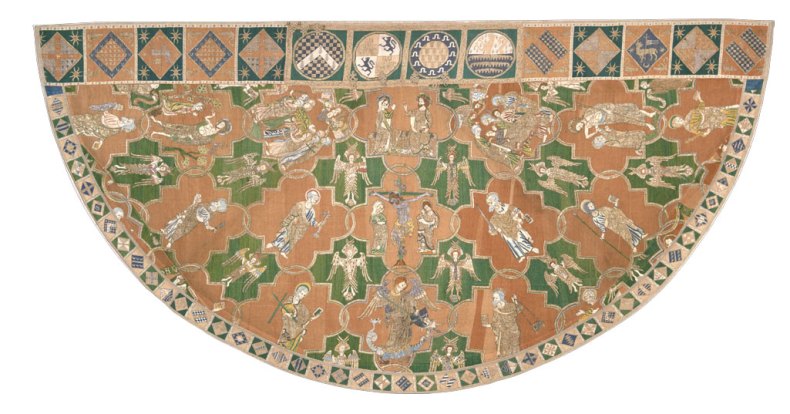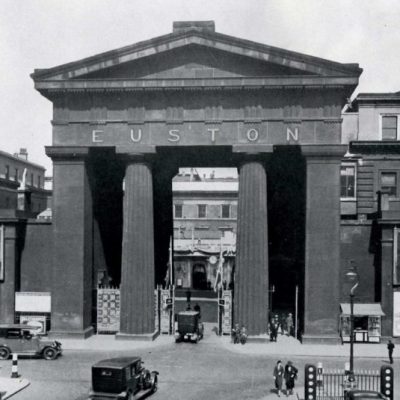At a time when we struggle to identify what, if anything, the UK exports to the world with any panache or in any abundance, the V&A provides a timely reminder of an era when England led the Western world in the manufacture and export of exquisite gold and silk embroidery. Such was its desirability that European patrons even afforded it its own name: ‘Opus Anglicanum’ – English work.
The extent of England’s trade in fine embroidery is spelt out at the beginning of the V&A’s comprehensive and scholarly new exhibition, ‘Opus Anglicanum: Masterpieces of English Medieval Embroidery’. A map details textile trading routes stretching east and south to the royal courts of France and Spain and on to Europe’s religious centre, Rome, and, more unexpectedly, north to Iceland. The luxurious quality of English embroidery is demonstrated by the show’s opening piece, the Bologna Cope (1310–20), a ceremonial cape worn by an officiating priest at the heart of religious ceremony. Over three metres wide and made up of thousands of silk split stitches and couched silver-gilt and silver threads, it illustrates scenes from the life of Christ framed by trefoil arches and spandrels filled with angels.
The Bologna Cope (1310–20), English. Convent of San Domenico, Bologna

Given the fragility and age of the embroideries, it is no surprise that most of the earliest textiles survive as distressed and faded fragments that can only hint at their former splendour. In two fragments of an apparel (1190–1220), Christ’s apostles are an almost spectral presence, holding their symbols aloft beneath an arcade in ruins, while the martyrdom of St Thomas à Becket appears shadow-like among the decoration on a priest’s mitre (1180–1210). The original iconography and colour of both objects can be reimagined through their sensitive juxtaposition with a contemporary illustration from The Harley Psalter (1190–1200) and the design on a reliquary casket (c. 1180–90). More extraordinary are the episcopal stockings and shoes from the tomb of Archbishop Hubert Walter (1170–1200), made of silk embroidered with silver eagles, lions and dragons and further embellished with glass. Preserved in near perfect condition for over 600 years, they were rediscovered in 1890 when Walter’s tomb in Canterbury Cathedral was opened.
Such was the sophistication of the medieval textile trade in the City of London that embroiderers’ names often appear in accounts, correspondence, and legal papers. Some enjoyed considerable success, like Thomas Carleton, who supplied embroidered vestments to Edward III and held the post of King’s Armourer from 1368. In a poignant touch, the exhibition curators have reunited what must once have been commonplace 14th-century tools – needle cases, a thimble, tiny sheers, and a needle – found during archaeological excavations in and around St Paul’s Cathedral and Cheapside with examples of the type of embroidery they were used to make. Further insight into the craft of medieval embroiderers is provided in a film demonstrating the painstaking stitching of silk and metal threads using the techniques of underside couching and split stitch, for which English embroiderers were famed.
The centrepiece of the exhibition is a breathtaking display of the monumental embroideries produced for the church in the late 13th century and first half of the 14th century, when demand for English embroidery was at its height. On loan from the Vatican Museums in Rome is the Vatican Cope (1280–1300), a vast semicircle of red silk adorned with three rows of eight-pointed stars containing brightly coloured saints and angels. The central crucifixion scene is particularly tender, an early example of Christ wearing a green crown of thorns and nailed to a cross of rough green wood to emphasise, as the catalogue entry notes, the connection with the living cross and Tree of Life. The magnificent Madrid Cope (c. 1300; orphrey [border], c. 1360) is a technically complex embroidery populated with figures from the Old Testament’s Book of Genesis, set in a golden landscape filled with six-winged seraphs and angels. In contrast is the more humane and grounded imagery of the story told in a set of panels depicting scenes from the Life of the Virgin (1335–45), illustrating St Anne as a new mother in bed, gently swaddling her baby.
Part of a horse trapper probably made for Edward III’s court (detail; 1330–40), English. Musee de Cluny, Paris

No less important were the secular embroideries created for the royal court and nobility. Described in detail in royal accounts, surviving examples are rare and have often avoided destruction through their association with important individuals. Fragments of a horse trapper (1330–40) are exquisite examples from a once larger set of textiles embroidered for King Edward III’s court in Paris. They are decorated with stylised golden lions baring their claws and surrounded by a foliate design featuring tiny figures further embellished with rock crystal and seed pearls and applied to a red velvet ground. Even rarer are pieces relating to the funeral achievements of Edward, the Black Prince (before 1376), which owe their survival to the tradition of carrying a knights’ personal helm and armour at his funeral and subsequently displaying them over his tomb. The surcoat of the Black Prince is severely faded and damaged, and although enough of the embroidery survives to pick out the royal arms of France and England, it requires an imaginative leap to connect it to the visual splendour of a knight’s embroidered tabard and matching horse trapper illustrated in a military roll of arms (before 1448), which provides a glimpse of the lavish decorative pageantry of a jousting tournament.
‘Opus Anglicanum’ concludes with embroidery of the later medieval period. Objects such as Cardinal John Morton’s Cope (1493), ‘powdered’ with silver-gilt and silk motifs of angels, stylised flowers and double-headed eagles applied to red velvet, reveal that developments in design and production did not reduce quality. However, the devastating impact of the English Reformation of the 1530s, during which many ecclesiastical embroideries were destroyed, cannot be overstated. Some, like the Steeple Aston Cope (1330–40) owe their survival to being cut and refashioned into furnishing textiles, while others were concealed by Catholic families or transported abroad. This history makes the quality and extent of the rare and fragile embroideries gathered from across Europe and North America in this beautifully conceived exhibition all the more remarkable for having survived at all.
The Syon Cope (detail; 1310–20), English. Victoria and Albert Museum, London

‘Opus Anglicanum: Masterpieces of English Medieval Embroidery’ is at the Victoria and Albert Museum, London, from 1 October–5 February 2017.
From the November issue of Apollo: Preview and subscribe here.



